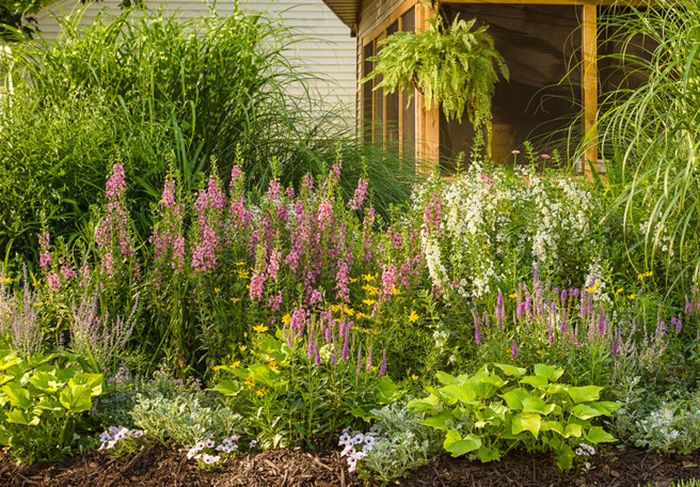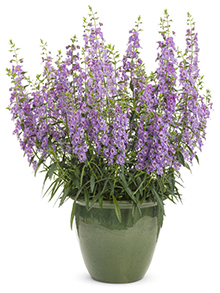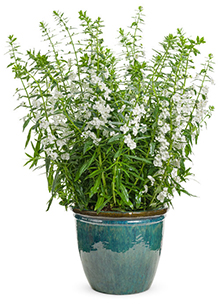Guide to Succeeding with Angelonia - Proven Winners Angelface®
Growing Angelonia, or summer snapdragon, is really pretty easy. Plant them in full sun to enjoy colorful flowers all season.

Buy angelonia plants - Order online and have them shipped right to your door
Succeeding with Angelface® Angelonia, commonly known as summer snapdragon, is really pretty simple. Other than full sun, they do not require any special growing conditions. They are easy to grow and thrive in the heat and humidity, even in the south. Plus, they'll bloom all season without removing the spent blossoms.
TYPES OF ANGELONIA
We offer three types of Angelface Angelonia:
- Standard
- Super
- Cascade
The main difference between them is the shape of the plant, or its habit.
| Standard types of Angelface Angelonia are mid-sized, 18-30" tall, upright plants with a bushy shape. They make perfect thrillers in container recipes and can be planted towards the front of a garden bed. Choose from Angelface Blue, Perfectly Pink, Steel Blue, Wedgwood Blue and White. |
| Super types of Angelface Angelonia are much larger, 30-40" tall, upright plants. They are so big that they can take the place of a small shrub in the landscape. Unless you are using a very large container, it's better to plant them in the ground so they can reach their full potential. Available in Super White. |
| Cascade types of Angelface Angelonia have an outward to downward spreading form rather than being strictly upright like the Standard and Super types. They are beautiful in hanging basket recipes and upright containers. Cascade Blue |
CARING FOR ANGELONIA
You will get the most out of your Angelface Angelonia if you provide for these basic needs.
Bring on the heat!
- Angelonia are heat-loving plants that grow and bloom best once the summer heat kicks in. Do you garden someplace where the summers are scorchers? Then these are the plants for you!
- Resist the temptation to purchase Angelface Angelonia if it is still too early to plant. If you live in an area where you tend to have late frosts or frigid spring weather, this can really slow the plants down if they get too cold. Wait to plant them until temperatures have warmed up in mid-spring or later.
Sun, sun and more sun.
- Angelface angelonia flowers grow and bloom best when planted in full sun, which means 6 or more hours of direct sunlight per day. See more full sun annuals.
- Though they can handle a little afternoon or morning shade, the brighter the sun, the easier it is for these plants to build up the energy they need for strong growth and flower production.
Don't overfeed.
- While the sun gives plants energy, the minerals and nutrients in plant food give the plants what they need to grow new leaves and flowers.
- When you first plant angelonia, incorporate our premium continuous-release plant food, which comes in a pellet form, into the soil. The special coating on the pellets is designed to release more food during warmer months when your plants are growing the fastest.
- After about 8 weeks, start to feed your angelonia with our premium water-soluble plant food once every ten days to two weeks. Why do we call it "premium"? Because it contains EDDHA iron and minor nutrients which keep the foliage green, full and healthy all season.
- If you plant angelonia in a garden bed, incorporate our premium continuous-release plant food or compost into the soil. No additional feeding should be needed to keep them happy and blooming for the rest of the season.
Don't forget to water!
- Angelonia is native to Central America and South America where rainfall is abundant. They grow best in consistently moist, but not soggy, soil. Once their roots are established, they can handle soils that are a bit drier.
- Do not let angelonia plants dry out to the point that they are wilting. This will make the lower leaves turn yellow and sap the energy out of the plant.
- If you are growing angelonia in a container, use a large pot that will hold a lot of soil and moisture. Hook it up to our WaterWise® drip irrigation system if you will not will be able to water by hand regularly. This will ensure your plants don't dry out, especially during the hottest summer days.
FREQUENTLY ASKED QUESTIONS
Is angelonia a perennial or an annual?
In most climates, they are grown as annuals. But, in USDA hardiness zones 10 to 11 they are a tender perennial. In these warm locations, they can last multiple growing seasons with frost protection.
How long do angelonias bloom?
Angelonias are long-blooming plants that provide continuous flowers throughout the growing season. With proper care and conditions, they will bloom from planting to frost.
Do deer eat angelonia?
Angelonia plants have good deer resistance due to their scented foliage. While no plant is completely deer-proof, they are known to be less appealing. However, deer preferences vary, and in certain circumstances, they may still nibble on them if other food sources are scarce.
Check out 30 Top Deer-Resistant Flowers
How tall do angelonia grow?
The height of Angelonia plants varies depending on the specific type or cultivar. Small types grow up to 12 inches, mid-size varieties reach approximately 18 inches, and larger ones can be 24 inches tall and up. Because of their height, they make great flowering thrillers in containers and are good as tall annuals for the middle of the border.
What to plant with angelonia?
Angelonia makes a good companion in flower beds, containers and more, especially if you are looking for a vertical accent. Plant it with petunia, verbena, calibrachoa, euphorbia, lantana, or any other plants that enjoy bright light.
Buy Proven Winners plants:
Looking for more ideas?
- See all the colors of Angelface angelonia we offer
- Explore container recipes featuring Angelface angelonia
- Request a FREE 36-page Gardener's Idea Book







